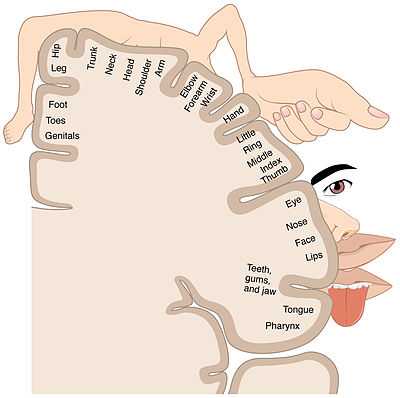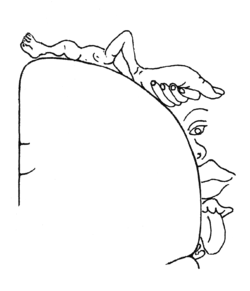Cortical homunculus

A cortical homunculus is a pictorial representation of the anatomical divisions of the primary motor cortex (i.e., portion of the human brain responsible for the processing and integration of motor information) and the primary somatosensory cortex[1] (i.e., portion of the human brain responsible for the processing and integration of tactile information).
The cortical homunculus is a visual representation of the concept of "the body within the brain"—that one's hand or face exists as much as a series of nerve structures or a "neuron concept", as it exists as a physical form. This concept relates to many neuro-biological phenomena including phantom limb and body integrity identity disorder.
The reason for the distorted appearance of the homunculus is that the amount of cerebral tissue or cortex devoted to a given body region is proportional to how richly innervated that region is, not to its size. The homunculus resembles an upside-down sensory or motor map of the contralateral side of the body. This can be seen, since the upper extremities such as the facial body parts and hands are closer to the lateral sulcus than lower extremities such as the leg and toes. The decussation in the pathways also result in right gyri to receive input from the left side of the body and vice versa.[2]
The resulting image is a grotesquely disfigured human with disproportionately huge hands, lips, and face in comparison to the rest of the body. Because of the fine motor skills and sense nerves found in these particular parts of the body, they are represented as being larger on the homunculus. A part of the body with fewer sensory and/or motor connections to the brain is represented to appear smaller.
Types
There are two types of homunculus, sensory and motor. Each one shows a representation of how much of its respective cortex innervates certain body parts. The primary somesthetic cortex (sensory) pertains to the signals within the postcentral gyrus coming from the thalamus. The primary motor cortex pertains to signals within the precentral gyrus coming from the premotor area of the frontal lobes. These are then transmitted from the gyri to the brain stem and spinal cord via corresponding sensory or motor nerves.
Motor cortex
At the primary motor cortex, motor representation is arranged quite orderly (in an inverted fashion) from the toe (at the top of the cerebral hemisphere) to mouth (at the bottom) along a fold in the cortex called the central sulcus. Some body parts may be controlled by partially overlapping regions of cortex, however. Each cerebral hemisphere of the primary motor cortex only contains a motor representation of the opposite (contralateral) side of the body.
The amount of primary motor cortex devoted to a body part is not proportional to the absolute size of the body surface, but, instead, to the relative density of cutaneous motor receptors on said body part. The density of cutaneous motor receptors on the body part generally is indicative of the necessary degree of precision of movement required at that body part. For this reason, the human hands and face have a much larger representation than the legs.
Somatosensory cortex
Likewise, at the primary somatosensory cortex, tactile representation is arranged orderly (in an inverted fashion) from the toe (at the top of the cerebral hemisphere) to mouth (at the bottom). Some body parts may be controlled by partially overlapping regions of cortex, however. Each cerebral hemisphere of the primary somatosensory cortex only contains a tactile representation of the opposite (contralateral) side of the body.
The amount of primary somatosensory cortex devoted to a body part is not proportional to the absolute size of the body surface, but, instead, to the relative density of cutaneous tactile receptors on that body part. The density of cutaneous tactile receptors on a body part is generally indicative of the degree of sensitivity of tactile stimulation experienced at said body part. For this reason, the human lip and hands have a larger representation than other body parts.
Development
Dr. Wilder Penfield used a similar image to depict the body according to the areas of the motor cortex controlling it in voluntary movement. Sometimes thought to be the brain's map of the body, the motor homunculus really is a map of the proportionate association of the cortex with body members. It also reflects kinesthetic proprioception, the body as felt in motion.
It plays a central role in phantom limb phenomena and their opposite, such as the disappearance of body members from conscious perception with certain types of brain damage. Similarly, the sensory homunculus, the motor homunculus looks distorted. For example the thumb, which is used in thousands of complex activities, appears much larger than the thigh with its relatively simple movement.
The motor homunculus develops over time and differs from one person to the next. The hand in the brain of an infant is different from the hand in the brain of a concert pianist. The difference is due to differences in the functional organization of associated areas of the brain, which in turn, is influenced by the muscular anatomy of the effector muscles of the hand.
Limitations
Penfield's motor homunculus, which usually is shown as a canonical, 2-D diagram is in actuality, an oversimplification that does not show the original data Penfield collected from patients undergoing surgery for epilepsy. This simplification suggests that lesions of the motor cortex will give rise to specific deficits in specific muscles. This is a misconception that is not necessarily the case: lesions produce deficits in groups of synergistic muscles. This difference is critical, as it suggests that the motor cortex functions in terms of overall movements as entire libraries, rather than how to move individual muscles, allowing a great deal more complexity.
Additional images
-

The idea of the cortical homunculus was created by Wilder Penfield.
See also
References
External links
- Mole-ratunculus an analogous example of a mole-rat, from paper